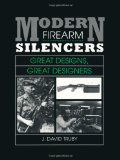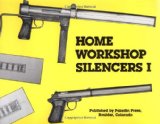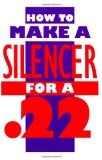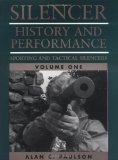by Shadow Spawn
Silencers
The manufacture of silencers [without proper licensing] is highly illegal in the United States. I am NOT responsible for ARREST, DEATH or DAMAGE. Remember if you construct one of the silencers in this article it is your choice.
There exists a great deal of misinformation surrounding the topic of firearm silencers or low signature systems as they are more correctly termed by those in military circles. The main source of misinformation seems to be the depiction of silenced weapons as being whisper-quiet by Hollywood. Those who know me can attest to the fact that I have built dozens of silencers in many different designs over the years and I have found that it just isn’t possible to produce a weapon which makes that slick “ffffhhhhhppp!” sound like in a James Bond movie. It is possible, however, to significantly reduce the level of noise which a discharging firearm makes and, more importantly, change the sound enough that it won’t be recognized as a firearm.
In order to effectively silence a firearm it is necessary to understand the four sources of noise which occur when a firearm is discharged:
Muzzle Blast – This is the result of hot propellant gasses exiting the muzzle and contacting the cooler air. This sound can be very loud.
Sonic Crack – If a bullet has a muzzle velocity which is higher than the speed of sound (approx 1,000fps) it will produce a sonic boom as it travels through the air. This sonic crack can make up a significant part of firearm noise. In order for a silencer to be really effective, subsonic ammunition must be made or obtained for the weapon to be silenced. Many weapons, including most blowback-action pistols and SMGs and most gas-operated rifles, will function properly when using subsonic ammo. Some weapons, including many recoil-operated pistols, have actions which will not fully cycle when firing the lower-powered, subsonic ammo. A number of cartridges are subsonic in their standard form, including the .22LR .22short and the .45 ACP. Weapons using these cartridges can be much more easily and more reliably silenced.
Action Cycling – This is the sound of the physical movement of the firearm’s action as it is discharged, the spent shell casing ejected and a fresh shell loaded. Semi and fully automatic weapons have heavy bolts which slam backward and spring forward upon discharge, making noise in the process. Fully-automatic, blowback weapons can produce quite a bit of noise just from the rapid cycling of their actions. Nothing can be done to reduce the noise of a cycling action.
Target Impact – The bullet striking its target will produce some impact sound. If it strikes something hard, such as metal or stone, quite a bit of noise will result. If, on the other hand, it strikes a soft target (i.e. human flesh) the resultant noise will be minimal. Beyond improving your marksmanship, there is little that can be done to prevent target impact noise.
A silencer is, of course, only capable of diminishing the sound of muzzle blast. A silencer works very much like a car’s muffler, it contains and dissipates the hot gasses from the exploding propellant preventing them from escaping into the cooler air and producing a loud muzzle blast. I have included some simple plans for building a firearm silencer which is “field tested” and which I know will work. This silencer can be easily and cheaply constructed and will perform nearly as well as an expensive silencer built in a machine shop.
The first step in building a silencer is to determine how to affix it to the weapon. The juncture between the muzzle and the silencer must be airtight, strong and fairly rigid. The best way to achieve this type of connection is to use a tap and die set to cut external threading on the end of the barrel to match internal threading on the silencer. This can be a difficult job because barrel steel is quite hard. It may be necessary to anneal the end of the barrel. This is done by using an oxy-acetylene torch to briefly heat up the end of the barrel, and then let it cool slowly. Be sure not to heat the steel to red-hot as it will retain some of its original hardness when it cools. A threaded junction is air tight, rigid, and able to withstand the pressures of even the most powerful cartridges. This method has the advantage of quick and easy installation or removal of the silencer. Many military style weapons come standard with threaded barrels in order to accept flash suppressors, compensators, bayonet lugs or rifle grenade launchers.
A second method is the split-tube and hose clamp approach. Without access to machine tools, this may be the method chosen by most operatives. The barrel extension tube, which makes up the core of the silencer, is slotted to fit past the sights and over the barrel. The slot is then tightened up behind the sights with a hose clamp of the appropriate size. With this method it may be necessary to use electrical tape on the barrel in order to ensure an airtight seal. This method is recommended for .22 caliber weapons only, anything more powerful would blow the silencer right off the gun.
Fastening a silencer to a firearm in this way makes it very difficult to keep the silencer aligned with the barrel. A very straight wooden dowel or a drill rod, of the proper diameter, can be placed in the barrel and through the silencer in order to make alignment simpler. Of course any jarring or rough treatment of the weapon may cause the alignment to be thrown out again. Installation and removal of the silencer are also made difficult with this method.
Improvised Silencer
The following instructions can be used to construct a simple, cheap and effective silencer for a .22 LR rifle or pistol. This design can be adopted to function for other firearm calibers, however, a threaded barrel/silencer junction is recommended for cartridges more powerful than .22 LR.
Materials Required:
- Drill Rod 7/32″ (for .22 weapons)
- At least 12″ of 1/4″ brake line or other strong metal tubing
- At least 12″ of 1 1/2″ PVC tubing and two end caps
- Fiberglass resin and hardener
- Several feet of fiberglass mat
- One roll of masking tape
- 1/8″ and 3/16″ drill bits
- Rubber bands
- Razor blades
- White lithium grease
- Eye dropper
- 6 wood screws
- Steel wool
- 80x sand paper
Construction:
Cut a 10″ section from the brake line and drill a series of 1/8″ holes along its length beginning 1 1/2″ from the end.
Next, enlarge the holes using a 3/16″ drill bit.
Using masking tape, mask off the end of the gun barrel and the first few inches. Be sure to keep the tape free of wrinkles to ensure a tight fit.
Place the drill rod down the barrel to keep the brake line aligned. Perfect alignment is extremely important. Sometimes the drill rod will be a little too large to fit into the barrel. In this case, chuck the drill rod into a drill and turn it down with a file or sandpaper, a little at a time, until it fits perfectly.
Wrap glass mat around the end of the gun barrel and brake line three times. Secure it in place with rubber bands every half inch. The glass mat should be wrapped about two inches behind the sight and up to the first holes on the brake line.
Now mix the resin. A few spoonfuls will do. Mix it two or three times hotter than the package directions.
Brace the weapon in an upright position and dab the resin onto the glass mat with a brush. Keep applying resin until the mat is no longer white but becomes transparent from absorption of the resin.
As soon as the resin starts to harden and becomes tacky, detach the brake line and fiberglass from the barrel. Do this quickly before the resin hardens completely.
First use a razor blade to cut a notch behind the front sight so that the whole piece can be removed. Then push on the fiberglass to slide it off. Do not pull it off from the other end as the alignment will be thrown off.
After removal from the gun barrel, peel out the tape and allow it to finish hardening.
Use a sander, grinder or 80x sandpaper to smooth out the hardened rough surface. Next, grind the sides down about halfway, but do not grind past the point where the front sight makes contact. Cut it down until the barrel fits snuggly and easily.
Stand the glassed brake line upright in a vise.
Mix a small amount of resin and use an eyedropper to fill in any interior holes or air bubbles until the solid fiberglass is level with the steel tube end. This will give the junction between the brake line and fiberglass coupling added strength. Acetone can be used to clean the eyedropper.
Cut the PVC tubing to the desired length. A longer silencer will be necessary for more powerful cartridges.
Drill a large hole in the center of one end cap, making it large enough to fit on the fiberglass end to the point where the front sight makes contact. Drill a series of 3/16″ holes in the bottom of the end cap.
Wrap masking tape around the end cap to cover the holes.
Stand the cap with the inside tube inserted into a vise. Get the cap level and straight with the brake line.
Cut two dozen or so 1/2″ squares of fiberglass mat and fill the end cap with it up past the level of the row of holes.
Mix resin and pour it over the cut matting to a point about 1/4″ above the holes and allow it to dry before removing the cap from the vise. Don’t worry about any resin that leaks out around the base hole. Resin fills the small holes, making the tube strong enough to withstand the muzzle blast.
When the inside is hardened, turn the assembly over and fiberglass around the backside of the end cap for added strength. Avoid getting resin in the opening where the barrel fits.
Place the finished cap and inner tube on one end of the PVC tubing that has already been cut to size. Center the brake line as you look in the open end of the PVC.
Now drill a 1/8″ hole in three places around the tube about 1/4″ from the lip of the cap.
Take the brake line out and enlarge the holes in the cap to 3/16″ Replace the brake line and tighten it down with three small wood screws.
Trim the brake line down until it extends about 1/2″ beyond the PVC tube.
Sharpen one end of the drill rod to a point and use it as a center-punch. Stand the assembly up with the solid end cap down. Drop the drill rod down the brake line to get a true center mark.
Using a drill bit slightly larger than the outside diameter of the brake line, remove the end cap and drill the hole.
Cut a circle of 1/4″ thick rubber which fits snuggly into the end cap. This rubber swipe will help prevent any hot gasses from escaping even after many shot have been fired through it because rubber tends to stretch and rip rather that have material blasted out of it by a gunshot. The hole will reseal itself after firing keeping the system nice and tight. Replace this swipe whenever the bullet hole becomes too large to contain gasses. This step will make a big difference, particularly in small silencers.
Replace the cap on the open end of the PVC tube and drill three 1/8″ holes around the cap as before for wood screws.
The brake line should push into and slightly stretch the rubber swipe. The swipe should not stick out past the face of the cap. Grind off the end of the brake line to get a perfect fit.
Unfold sections of steel wool and roll into long strands.
Apply white lithium grease to each strand before feeding them into the silencer tube in a circular motion. The white grease helps to cool the hot gasses of the muzzle blast, thereby reducing the loudness of the gunshot. Pack the steel wool tight with a stick, continue this until the silencer tube is completely full. Replace the end cap with the three screws.
Paint the finished silencer flat black and attach it to your weapon. Proper alignment can be ensured by using a hose clamp around the barrel extension behind the front sight. Test as described in the Silenced .22 LR Weapons.
This silencer can be counted on to function for over 300 rounds before it will be necessary to open it up and repack it with new steel wool and lithium grease.






